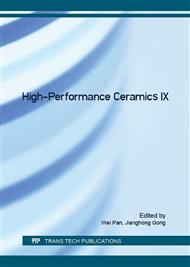p.243
p.248
p.253
p.257
p.262
p.267
p.271
p.275
p.279
Influence of CeO2-Doping on the Electrical Properties of ZnO-Bi2O3-Based Varistor Ceramics
Abstract:
The microstructure and electrical properties of CeO2-doped ZnO-Bi2O3-based varistors were investigated for different amounts of the dopant. The phase composition of CeO2-doped samples was similar to the undoped samples. Ce mainly segregated at the grain boundaries within the EDS detection limit. The average grain size decreased from 7.3 to 6.7 μm and the breakdown voltage increased from 438 to 501 V/mm when the content of CeO2 ranged from 0 to 0.2 mol%. The nonlinear coefficient increased from 38 to 51 when the content of CeO2 increased from 0 to 0.1 mol%., but the further doping caused it to decrease up to 44 at 0.2mol%. The leakage current decreased from 1 to 0.4 μA/cm2 when the content of CeO2 ranged from 0 to 0.1 mol%. Then it increased to 0.7 μA/cm2 at 0.2 mol%. The density of interface states, the barrier height and the donor concentration increased when the content of CeO2 ranged from 0 to 0.1 mol%, but decreased at 0.2 mol%. Hence, when the content ranges from 0 to 0.1 mol%, CeO2 acts as a donor and can improve the electrical properties.
Info:
Periodical:
Pages:
262-266
Citation:
Online since:
July 2016
Authors:
Keywords:
Price:
Сopyright:
© 2016 Trans Tech Publications Ltd. All Rights Reserved
Share:
Citation:


